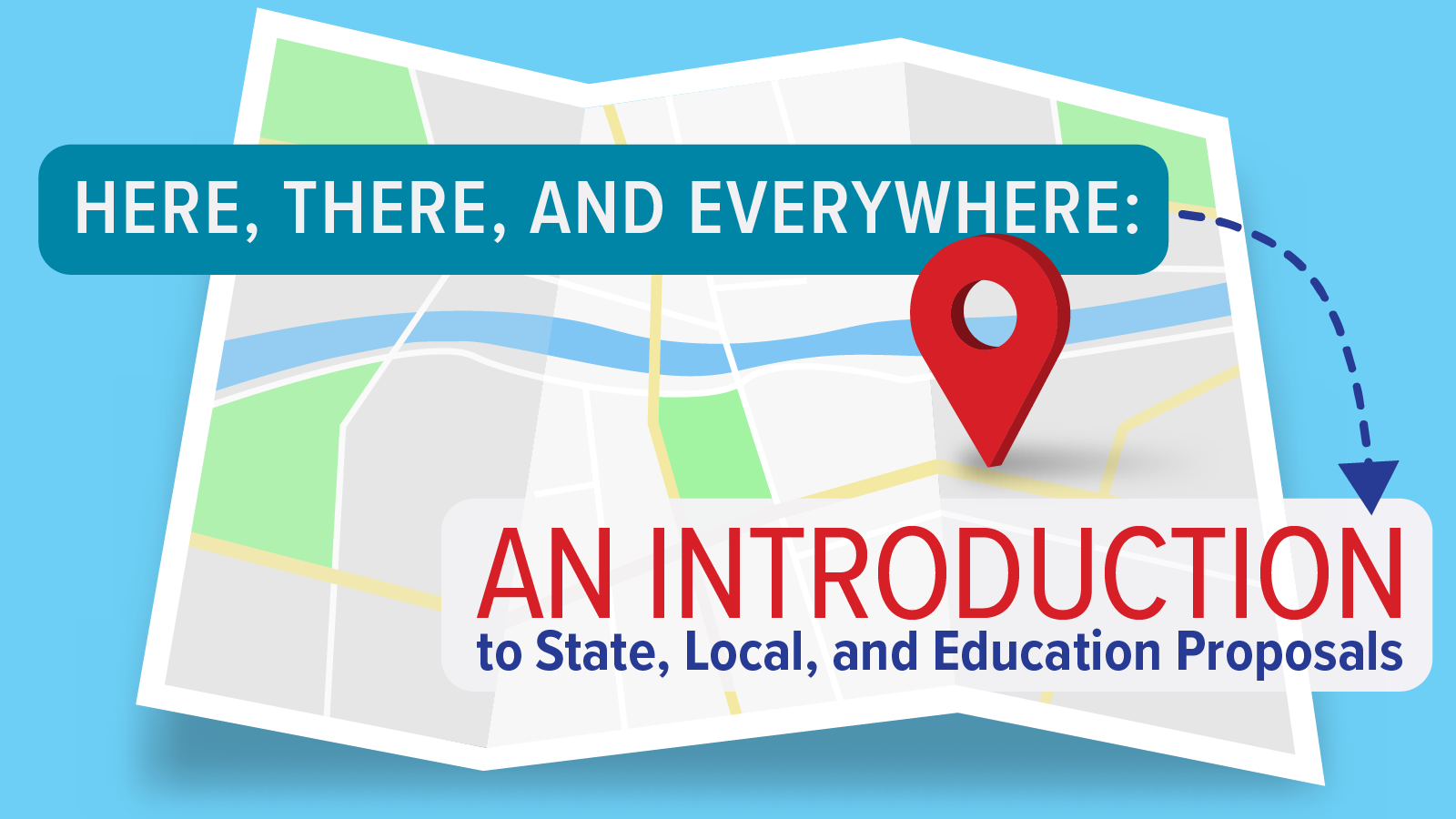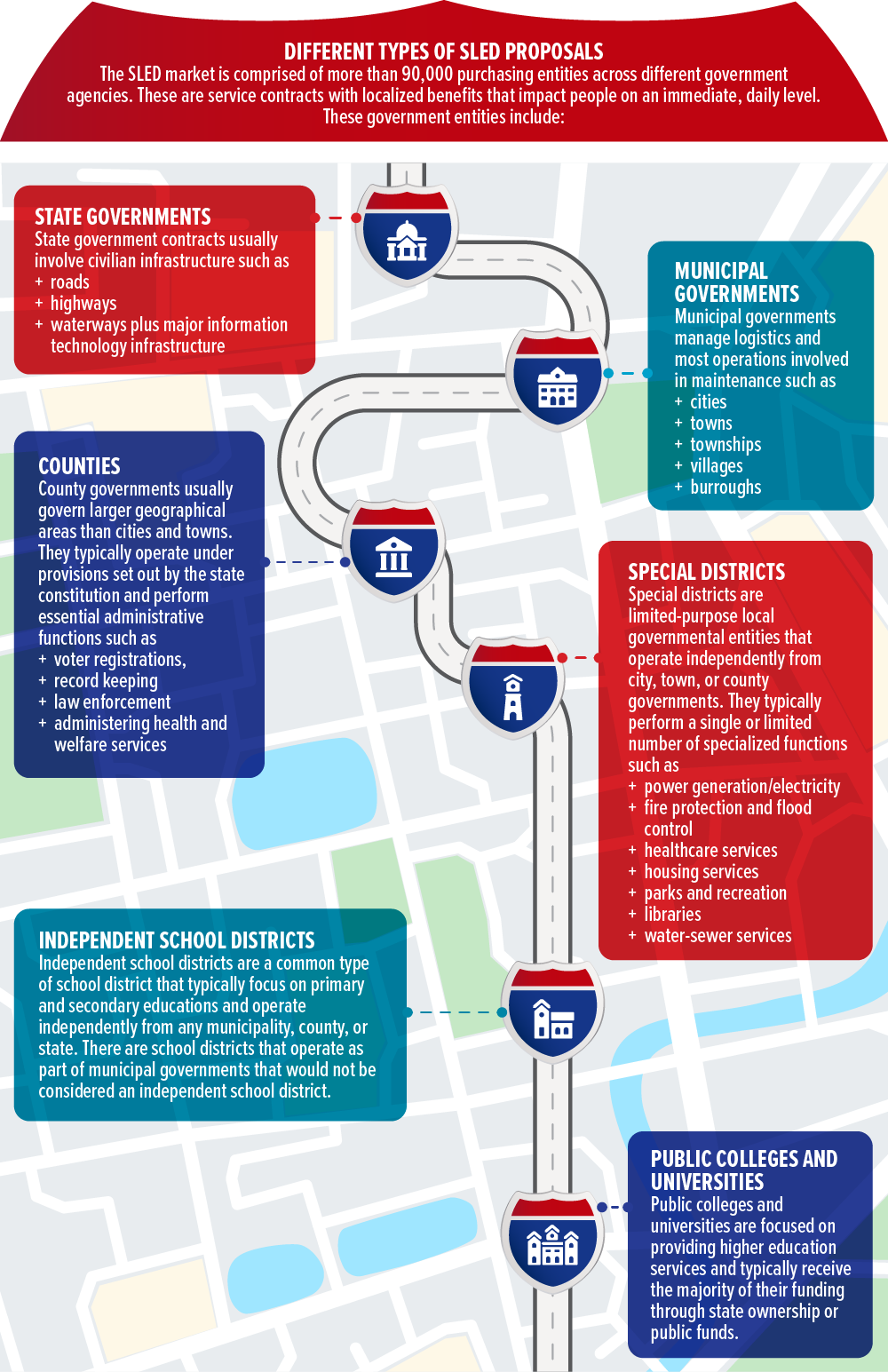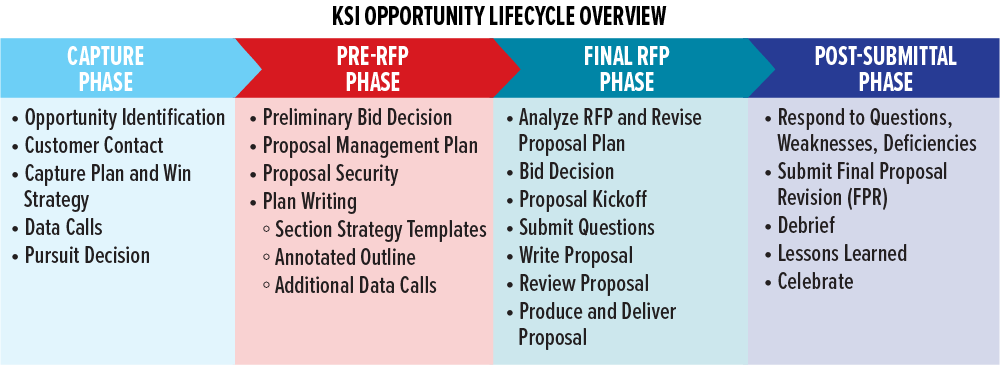
If you’ll indulge in a music analogy, Federal Government Contracting in the United States is a long and winding road, while State, Local, and Education (SLED) contracting is a smaller ticket to ride. But hey, you still might want to drive that car!
Like a great song, successful SLED proposals are meaningful and could still make you a lot of money! This article will help you understand more about these proposals and how you can leverage them for success.
1. What is a SLED Proposal?
Comprising a wide array of service requests for proposals (RFPs) in all 50 states, SLED (State, Local, and Education) is a tremendous revenue opportunity with differing requirements and revenue potential.
SLED procurement dollars are approximately three times the amount the federal market spends. More than 100,000 state and local government purchasing entities are engaged in evaluating and buying various products and services. This results in more than 500,000 RFPs published by SLED agencies annually! Tremendous revenue opportunities.
SLED agencies, moreover, unlike the federal government, maintain their own business schedules, and their budgeting/buying is frequently parallel with their respective state’s fiscal year. The state, local, and education (SLED) procurement market is a massive opportunity for your company to expand its sales potential.

2. Different Types of SLED Proposals
The SLED market comprises more than 100,000 purchasing entities across different government agencies. These are service contracts with localized benefits that impact people on an immediate, daily level. These government entities include:

- State governments: State government contracts usually involve civilian infrastructures such as roads, highways, and waterways plus major information technology infrastructure. State governments maintain police and fire services, zoning regulations, licensing professions, and elections.
- Municipal Governments: Municipal governments manage logistics and most operations in maintaining cities, towns, townships, villages, and boroughs.
- Counties: County governments usually govern larger geographical areas than cities and towns, so their service responsibilities are often great, but their budgets and requirements are generally smaller than states. They typically operate under provisions set out by the state constitution and perform essential administrative functions such as voter registrations, record keeping, law enforcement, and administering health and welfare services.
- Special Districts: Special districts are limited-purpose local governmental entities that operate independently from city, town, or county governments. They typically perform a single or limited number of specialized functions. Common services that special districts provide include power generation/electricity, fire protection, flood control, healthcare services, housing services, parks and recreation, libraries, water-sewer services, and even entertainment venues and services.
- Independent School Districts: Independent school districts are a common type of school district that typically focus on primary and secondary education and operate independently from any municipality, county, or state. There are school districts that operate as part of municipal governments that would not be considered independent school districts.
- Public Colleges and Universities: Public colleges and universities are focused on providing higher education services and typically receive most of their funding through state ownership or public funds.
3. Executing SLED Proposals
Managing and executing SLED proposals is a similar process to what you would do with larger federal proposals but with quicker turnarounds and thus more opportunity to enhance your revenue throughout the year.
Some bids take only weeks from RFP release to the due date, while others are released and due within a short period of months. Despite the time constraints, we advise that you utilize the same approach, compressed as needed, for larger federal proposals. For SLED proposals, you will use the same methodologies as you do for larger government contracts. You can find proposal management best practices in the KSI Advantage™ Capture & Proposal Guide, which can be modified with varying timeframes as SLED proposals are nearly always much shorter in duration.
Much like Federal opportunities, SLED opportunity lifecycles follow a similar preparation process to the KSI Advantage™ Opportunity Lifecycle:
- Capture Phase
- Pre-RFP Phase
- Final RFP Stage
- Post-Submittal Stage
The graphic below summarizes the four phases. A larger lifecycle can be found in the KSI Advantage™ Capture & Proposal Guide.

As in any instance when writing to a set deadline, there are concurrent tasks which include writing proposal sections and crafting compelling content for executive summaries, management sections, technical sections, Past Performance, and resumes. Processes for developing content for these types of sections in Federal and SLED proposals are similar in strategy, design, and submittal. Depending on the state, oral presentations may also be required.
4. Why Pursue SLED Proposals?
SLED agencies are responsible for purchasing goods and services valued at nearly $1.5 trillion annually. The SLED government market represents nearly 10% of the United States GDP!
The majority of awards will be for lesser amounts than $1,000,000. For every contract at $1 million or more, there will generally be five lesser than that, from $100,000 to $260,000 across multiple industries. About 16% of awards exceed $1 million in value. But the point remains that the SLED market is a more than viable and lucrative pursuit.

5. SLED Proposals in the Post-Pandemic Era
Two years since the COVID-19 virus shut down much of the world, a silver lining to this global pandemic is various industries are reemerging with a stronger, more nimble approach.
One benefit to productivity and work/life balance is the emergence of virtual teams as a consistent, positive part of the proposal management industry. Since SLED proposals involved core team members from all over the country, there are distinct advantages to using virtual teams for proposal management:
- Cost savings
- Leverage Diverse Talent
- Increased Productivity & Higher Profits
- Reduced Time to Market
- Newer Opportunities
Conclusion
Don’t be the Fool on the Hill who only considers federal government contracts. SLED proposals are worth considering along with Federal proposals or as an alternative to that business. They are diverse, meaningful contracts to pursue that help your cash flow throughout the year and enable you to diversify your staff. Contact KSI to learn more about how to grow your business with these lucrative opportunities!
References and Resources:
- "SLED Government Contracting 101." Deltek.
- "10 Hotspots in State & Local Government Contracting for 2022."Deltek. April 2022.
- "Sizing up the $1.5 Trillion State & Local Contracting Market." Onvia (now Deltek). 2015.








